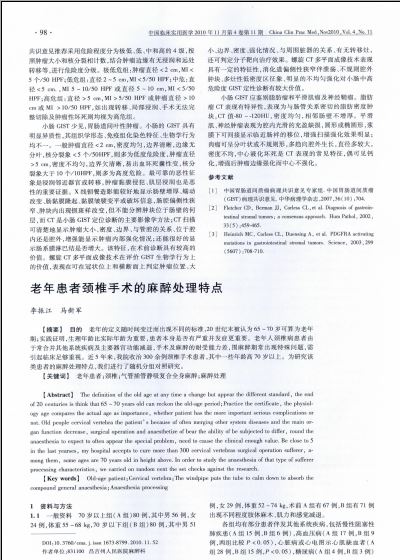老年患者颈椎手术的麻醉处理特点(1)
 |
| 第1页 |
参见附件(1945KB,3页)。
【摘要】 目的 老年的定义随时间变迁而出现不同的标准,20世纪末被认为65~70岁可算为老年期;实践证明,生理年龄比实际年龄为重要,患者本身是否有严重并发症更重要。老年人颈椎病患者由于常合并其他系统疾病及主要器官功能减退,手术及麻醉的耐受能力差,围麻醉期常出现特殊问题,需引起临床足够重视。近5年来,我院收治300余例颈椎手术患者,其中一些年龄高70岁以上。为研究该类患者的麻醉处理特点,我们进行了随机分组对照研究。
【关键词】
老年患者;颈椎;气管插管静吸复合全身麻醉;麻醉处理
【Abstract】 The definition of the old age at any time a change but appear the different standard, the end of 20 centuries is think that 65~70 years old can reckon the old-age period;Practice the certificate, the physiology age compares the actual age as importance, whether patient has the more important serious complications or not.Old people cervical vertebra the patient’s because of often merging other system diseases and the main organfunction decrease, surgical operation and anaesthetize of bear the ability of be subjected to differ, round the anaesthesia to expect to often appear the special problem, need to cause the clinical enough value.Be close to 5 in the last yearses, my hospital accepts to cure more than 300 cervical vertebras surgical operation sufferer, among them, some ages are 70 years old in height above.In order to study the anaesthesia of that type of suffererprocessing characteristics, we carried on random cent the set checks against the research.
【Key words】 Old-age patient;Cervical vertebra;The windpipe puts the tube to calm down to absorb the compound general anaesthesia;Anaesthesia processing
DOI:10.3760/cma.j.issn 1673-8799.2010.11.52
作者单位:831100昌吉州人民医院麻醉科
1 资料与方法
1.1 一般资料 70岁以上组(A组)80例,其中男56例,女24例,体重55~68 kg,70岁以下组(B组)80例,其中男51例,女29例,体重52~74 kg,术前A组有67例,B组有71例出现不同程度肢体麻木、肌力和感觉减退。
各组均有部分患者伴发其他系统疾病,包括慢性阻塞性肺疾患(A组15例、B组6例),高血压病(A组17例,B组9例,两组比较P<0.05),心脏病或心电图示心肌缺血者(A组28例,B组15例,P<0.05),糖尿病(A组4例,B组3例)以及肝肾疾病(A组11例,B组6例)。
患者手术方式可归纳为4种:前路减压植骨内固定(A组23例,B组38例),后路减压植骨内固定(A组26例,B组20例),颈椎管内肿瘤切除术(A组22例,B组15例)以及颈椎间盘突出椎管减压髓核摘除术(A组9例,B组7例)。1.2 麻醉方法 全部病均采用气管插管静吸复合全麻。其中A组28例、B组24例因颈椎活动严重受限,充分咽喉部和气管表面麻醉后行经鼻清醒盲探插管,插管前先给半量氟芬合剂,以减轻插管刺激。对2~3次盲探插管不成功者,改为纤支镜导引插管,减少喉部损坏,其余病例均采用静脉快诱导插管。用药店量及次序:芬太尼2 μg/kg,丙泊酚1 mg/kg或依托咪酯0.3 mg/kg、维库溴铵0.1 mg/kg。麻醉维持用(1.0+0.5)MAC安氟醚或异氟醚吸入,其中A组58例、B组65例合并芬太尼及维库溴铵间歇静注,A组22例,B组15例复合静脉丙泊酚麻醉。监测术中行控制呼吸,VT8~10 ml/kg,RR10~11次/min,维持SPO2≥96%,维持PETCO24.55.5 kPa。监测BP、ECG。
1.3 统计分析 观察数据行 χ2检验,P<0 ......
您现在查看是摘要介绍页,详见PDF附件(1945KB,3页)。